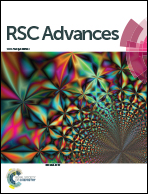Solvothermal synthesis of pyrite FeS2 nanocubes and their superior high rate lithium storage properties†
Abstract
Iron pyrite nanocubes with particle sizes of around 80–120 nm have been synthesized via a facile solvothermal method. Time-dependent characterization found that the iron(II) chloride and sulfur precursors first react to form sheet-like amorphous Fe1−xS, which transforms into pyrite FeS2 nanocubes upon further heating. As an anode material for lithium ion batteries, the as-synthesized pyrite FeS2 nanocubes were found to deliver a reversible discharge capacity of 540 mA h g−1 after cycling for 150 cycles at a current density of 1 A g−1. Even at higher current density of 5 A g−1, the pyrite FeS2 electrode still managed to give a stable discharge capacity of about 220 mA h g−1. The enhanced lithium storage properties are attributed to its higher specific surface area that can provide more lithium ion (Li+) reaction sites, leading to less polarization and better cycling performance.


 Please wait while we load your content...
Please wait while we load your content...